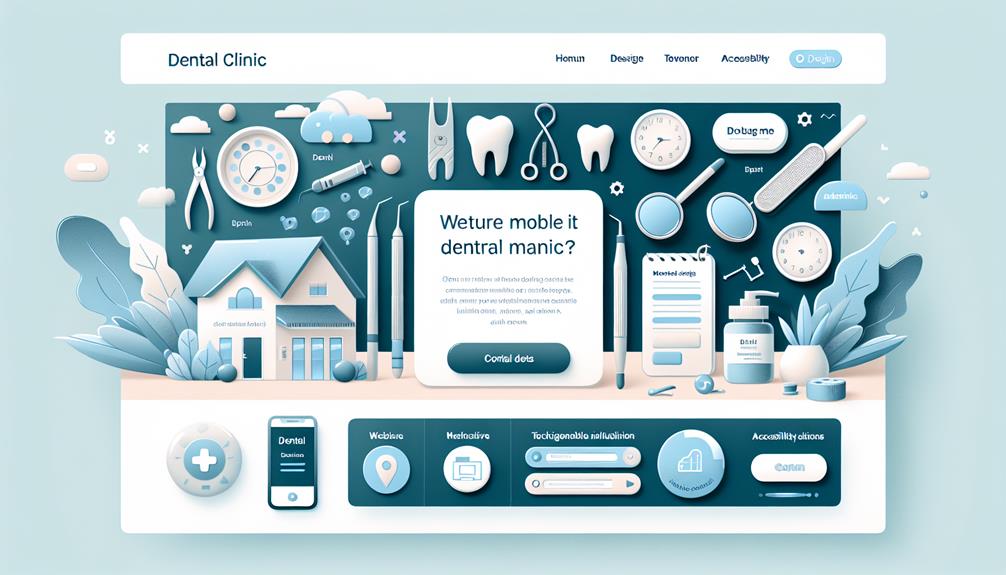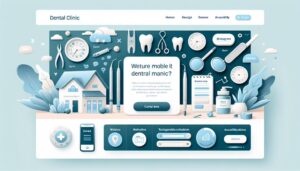When it comes to the online presence of your dental practice, ensuring a seamless user experience is not just about aesthetics but also impacts your SEO performance. User-friendly design, intuitive navigation, engaging content, swift page loading speeds, and mobile responsiveness all play crucial roles in how search engines perceive and rank your website.
But have you considered how user feedback ties into optimizing your site for SEO? There’s more to the connection between user experience and SEO than meets the eye, and uncovering these intricacies could be the key to boosting your dental website’s visibility and success.
Importance of User-Friendly Design
To enhance user experience and boost SEO rankings, prioritizing user-friendly design is imperative for dental websites. Visual appeal plays a crucial role in capturing visitors’ attention and making a positive first impression. A well-designed website with visually appealing elements such as high-quality images, a harmonious color palette, and clean layouts can engage users and keep them interested in exploring further.
Usability testing is another essential aspect of user-friendly design that ensures visitors can navigate the website easily and find the information they need quickly. Conducting usability tests helps identify any potential issues or roadblocks that users may encounter while interacting with the site. By addressing these issues promptly, dental websites can improve the overall user experience and increase user satisfaction.
Incorporating user-friendly design principles not only enhances the aesthetics of a dental website but also contributes to higher user engagement, reduced bounce rates, and improved SEO performance. By focusing on visual appeal and usability testing, dental websites can create a seamless and enjoyable experience for visitors, ultimately leading to better search engine rankings and increased traffic.
Enhancing Website Navigation
Improving website navigation is key to enhancing user experience and optimizing SEO performance for dental websites. When users can easily find what they need, they’re more likely to stay on your site longer, engage with your content, and ultimately convert.
To enhance your website navigation, consider the following:
- Interactive elements: Incorporate interactive features like dropdown menus or clickable buttons to make navigation more engaging and intuitive.
- Visual hierarchy: Use visual cues such as colors, fonts, and sizes to guide users’ attention to important sections and make it easier for them to navigate through your site.
- Clear calls to action: Ensure that your calls to action are prominent and easily accessible, prompting users to take the desired actions on your website.
- Intuitive layout: Organize your content in a logical manner, making it easy for visitors to navigate through different pages and sections seamlessly.
Role of Engaging Content
When it comes to dental websites, the quality of your content directly impacts user engagement and search engine visibility. Engaging content not only informs visitors but also keeps them on your site longer, signaling to search engines that your site is valuable.
Content Quality Impact
Engaging content plays a pivotal role in enhancing user experience and driving organic traffic on dental websites. When it comes to content quality impact, here are some key factors to consider:
- Visual Appeal: Incorporating high-quality images and videos can capture users’ attention and make the content more engaging.
- Information Accuracy: Providing accurate and up-to-date information on dental seo services, procedures, and hygiene practices builds trust with users.
- Readability: Using clear and concise language ensures that users can easily understand the content without feeling overwhelmed.
- Call-to-Action: Including relevant CTAs encourages users to take the desired actions, such as scheduling an appointment or contacting the dental practice for more information.
Audience Engagement Importance
To enhance user experience and drive organic traffic on dental websites, it’s crucial to understand the pivotal role that audience engagement plays in captivating and retaining visitors. Interaction metrics such as average session duration, bounce rate, and pages per session are essential indicators of user engagement.
By creating engaging content that educates and entertains visitors, dental websites can increase user retention and encourage repeat visits. High-quality visuals, interactive tools like appointment schedulers or virtual consultations, and informative blog posts can all contribute to a more engaging user experience.
Monitoring user feedback and adapting content based on audience preferences can further enhance engagement levels and ultimately lead to improved SEO performance for dental websites.
Impact of Page Loading Speed
How does page loading speed impact user experience and SEO performance on dental websites?
When it comes to dental websites, the speed at which your pages load can significantly influence user engagement and search engine rankings. Here are some key points to consider:
- Conversion Optimization: Slow loading times can lead to higher bounce rates, reducing the chances of converting website visitors into leads or customers.
- SEO Performance: Search engines like Google consider page loading speed as a ranking factor, meaning faster sites are more likely to appear higher in search results.
- User Experience: A speedy website enhances user experience, keeping visitors engaged and more likely to explore different sections of your site.
- Image Optimization: Optimizing images by compressing them without compromising quality can help improve page loading speed, leading to a better overall user experience and SEO performance.
Mobile Responsiveness for SEO
Ensure your website is mobile-responsive as it directly impacts your SEO performance.
With Google prioritizing mobile-friendly sites, having a responsive design can boost your search rankings.
Mobile usability is crucial for user experience, influencing both SEO and visitor retention rates.
SEO Impact of Responsiveness
Mobile responsiveness plays a crucial role in enhancing the search engine optimization (SEO) performance of dental websites. When it comes to SEO impact, responsiveness is key for improved rankings and user experience. Here are four reasons why mobile responsiveness matters for SEO:
- Improved User Experience: Responsive sites offer a seamless experience across devices, reducing bounce rates.
- Faster Page Speed: Mobile-friendly sites load faster, positively impacting SEO rankings.
- Google’s Mobile-First Indexing: Responsive websites are favored by Google, leading to better SEO rankings.
- Lower Bounce Rates: A responsive design keeps visitors engaged, lowering bounce rates and signaling quality to search engines.
Mobile Usability Importance
Enhancing the mobile usability of dental websites significantly boosts their SEO performance. Responsive design and mobile optimization are crucial for ranking well on search engines.
Did you know that Google prioritizes mobile-friendly websites in its search results? In fact, websites that aren’t optimized for mobile devices risk lower visibility and reduced traffic.
Studies show that more than half of all website traffic comes from mobile devices, underlining the importance of a seamless mobile user experience. By adopting responsive design principles and ensuring your website is mobile-friendly, you can improve your SEO rankings and attract more visitors.
User Feedback and SEO Optimization
To enhance the performance of dental websites in search engine rankings, incorporating user feedback is crucial for optimizing SEO strategies. User feedback plays a significant role in improving conversion rates and user retention, ultimately impacting the overall SEO of a dental website.
Here are four key ways user feedback can enhance SEO optimization:
- Identifying Pain Points: User feedback helps uncover areas of improvement on your website that may be hindering user experience or conversion rates.
- Enhancing Content Relevance: Feedback allows you to tailor your content to better meet the needs and preferences of your target audience, improving SEO relevance.
- Improving Site Navigation: Understanding user feedback can help streamline website navigation, making it easier for visitors to find what they’re looking for, leading to increased user retention.
- Boosting Engagement: By listening to user feedback, you can create a more engaging website that encourages visitors to spend more time on your site, positively impacting SEO metrics.
Frequently Asked Questions
How Does the Color Scheme and Layout of a Dental Website Impact SEO Rankings?
When you consider the color scheme and layout of a dental website, you impact SEO rankings. Typography choices affect user engagement, while navigation design influences user retention. Optimize these elements for better SEO results.
Can Incorporating Interactive Features Like Virtual Consultations or Appointment Scheduling Improve SEO Performance?
Incorporating interactive features like virtual consultations and appointment scheduling can boost your SEO performance. Patient testimonials and online reviews can enhance website rankings. Engaging tools offer a user-friendly experience, driving traffic and improving search engine visibility.
Are There Specific Types of Multimedia Content, Such as Videos or Animations, That Can Boost SEO on Dental Websites?
To improve SEO on dental websites, consider incorporating infographics, podcasts, webinars, and quizzes. These multimedia elements engage users, boost interaction, and increase site relevance. Including diverse content types enhances user experience and search engine visibility.
How Does the Use of Chatbots or Live Chat Functionalities Affect User Experience and SEO on Dental Websites?
When you add chatbots or live chat to your dental website, user engagement increases. Quick customer support boosts conversion rates. These features improve your online presence, making your site more interactive and accessible to visitors.
Is There a Correlation Between Social Media Integration on Dental Websites and SEO Rankings?
Boost your SEO rankings by integrating social media on dental websites. Enhance social engagement for increased brand awareness and online visibility. Connect with your audience, improve SEO, and watch your online presence soar.
Conclusion
When it comes to dental websites and SEO, user experience is key.
From user-friendly design to engaging content and fast page loading speeds, every aspect plays a crucial role in optimizing your site for search engines.
Imagine a seamless online journey for your visitors, where they effortlessly find the information they need and have a pleasant browsing experience.
By prioritizing user experience, you not only improve your SEO but also create a positive impact on your audience.

Suraj Rana is a renowned Dental SEO Expert, deeply committed to elevating dental practices in the online landscape. With a profound understanding of technical SEO, he specializes in tailoring on-page optimization strategies specifically for the dental industry. Suraj’s extensive experience spans across various sectors, but his passion truly lies in transforming the digital presence of dental clinics. His expertise in dental-specific search engine optimization, combined with a data-driven approach, empowers him to develop strategies that significantly increase organic traffic, enhance search engine rankings for dental-related keywords, and ultimately drive business growth for his dental clients. Suraj Rana’s unique blend of SEO skills and dedication to the dental field make him an invaluable asset to any dental practice looking to thrive online.


